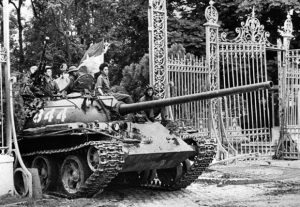 From November 1, 1955 until April 30, 1975, the Vietnam war raged. The United States entered the war on March 8, 1965. It was an unpopular war from the start. Those who protested US involvement felt like it wasn’t our war and we shouldn’t be there. Be that as it may, we were there, and for the time being, we weren’t going anywhere. The war was a long one, but on April 30, 1975, it came to an abrupt end, when Saigon fell.
From November 1, 1955 until April 30, 1975, the Vietnam war raged. The United States entered the war on March 8, 1965. It was an unpopular war from the start. Those who protested US involvement felt like it wasn’t our war and we shouldn’t be there. Be that as it may, we were there, and for the time being, we weren’t going anywhere. The war was a long one, but on April 30, 1975, it came to an abrupt end, when Saigon fell.
At dawn that spring morning, communist forces moved into Saigon, where they received only sporadic resistance. The South Vietnamese forces had collapsed under the rapid advancement of the North Vietnamese. The most recent fighting had begun in December 1974. That was when the North Vietnamese launched a major attack against the lightly defended province of Phuoc Long, which was located due north of Saigon along the Cambodian border, overrunning the provincial capital at Phuoc Binh on January 6, 1975. Despite previous promises, from President Nixon, to provide aid if the communists attacked Saigon, the United States did nothing. The problem…Nixon had resigned from office and his successor, Gerald Ford, was unable to convince a hostile Congress to keep Nixon’s earlier promises to rescue Saigon from communist takeover. The United States had its own set of tumultuous circumstances to deal with at that time.
The lack of response from the United States emboldened the North Vietnamese, who launched a new campaign  in March 1975. The South Vietnamese forces fell back in total chaos, and once again, the United States did nothing. The South Vietnamese abandoned Pleiku and Kontum in the Highlands with little to no fighting. Then Quang Tri, Hue, and Da Nang fell to the communist onslaught. The North Vietnamese continued to attack south along the coast toward Saigon, defeating the South Vietnamese forces at each encounter.
in March 1975. The South Vietnamese forces fell back in total chaos, and once again, the United States did nothing. The South Vietnamese abandoned Pleiku and Kontum in the Highlands with little to no fighting. Then Quang Tri, Hue, and Da Nang fell to the communist onslaught. The North Vietnamese continued to attack south along the coast toward Saigon, defeating the South Vietnamese forces at each encounter.
The South Vietnamese 18th Division had fought a valiant battle at Xuan Loc, just to the east of Saigon, destroying three North Vietnamese divisions in the process. They were the only division that seemed capable of continuing the fight. That was to be the last battle in the defense of the Republic of South Vietnam. The South Vietnamese forces held out against the attackers until they ran out of tactical air support and weapons, finally abandoning Xuan Loc to the communists on April 21, 1975.
Having crushed the last major organized opposition before Saigon, the North Vietnamese got into position for the final assault. In Saigon, South Vietnamese President Nguyen Van Thieu resigned and transferred authority to Vice President Tran Van Huong before fleeing the city on April 25. By April 27, the North Vietnamese had  completely encircled Saigon and began to maneuver for a complete takeover. When they attacked at dawn on April 30, they met little resistance. North Vietnamese tanks crashed through the gates of the Presidential Palace and the war came to an end. North Vietnamese Colonel Bui Tin accepted the surrender from General Duong Van Minh, who had taken over after Tran Van Huong and had only spent only one day in power. Tin explained to Minh, “You have nothing to fear. Between Vietnamese there are no victors and no vanquished. Only the Americans have been beaten. If you are patriots, consider this a moment of joy. The war for our country is over.” Of course, this also meant that Vietnam would be a Communist country, like it or not.
completely encircled Saigon and began to maneuver for a complete takeover. When they attacked at dawn on April 30, they met little resistance. North Vietnamese tanks crashed through the gates of the Presidential Palace and the war came to an end. North Vietnamese Colonel Bui Tin accepted the surrender from General Duong Van Minh, who had taken over after Tran Van Huong and had only spent only one day in power. Tin explained to Minh, “You have nothing to fear. Between Vietnamese there are no victors and no vanquished. Only the Americans have been beaten. If you are patriots, consider this a moment of joy. The war for our country is over.” Of course, this also meant that Vietnam would be a Communist country, like it or not.


Leave a Reply